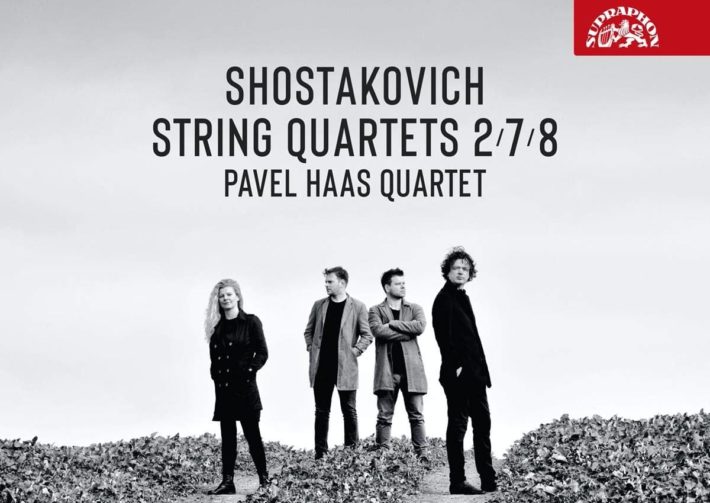The Pavel Haas Quartet has made a name for itself with a solid discography of, among others, Czech composers. In a new Supraphon release, it takes on a new project, recording Shostakovich String Quartets 2, 7, and 8. These quartets, which deeply mirror the composer’s own life and deep conflicts, present quite the musical challenge for any ensemble. In a recent interview, the group mentions having a close personal connection to the quartets and that they represent a “spiritual cross-section of [the composer’s] entire life.” This sentiment is well reflected in their playing. What the Pavel Haas Quartet brings to the forefront incredibly well are the nuanced emotional facets of the quartets, ranging from irony to tragedy, to madness.
Written in a little under three weeks in 1944, Quartet No. 2 Op. 68, portrays Shostakovich at odds between political circumstance and personal conviction. With the Soviet-German War underway, Shostakovich was put in a government retreat to write this quartet along with his Piano Trio (Op. 67). What is reflected in the quartet is not so much a commentary on the war as a reflection of his own cognitive dissonance, and this is what the Haas quartet so effectively reveals. Its interpretation of the first and third movements are notable. In the former, the performers show the vibrant multi-dimensionality of emotions, ranging from the robust A-major opening to the menacing nature of the middle section. With so many character changes, a significant challenge for any group is to keep the energy flowing throughout. The ensemble does this impressively. Despite the plethora of dissonances in Shostakovich’s writing, the players also maintain good sound quality, one that prevents the notes from sounding too abrasive but that still captures their jarring nature. In the third movement, the musicians capture the odd lilt of the waltz with the subtle and well-harmonized waltz accompaniment against the ebb and flow of the melodic line. The cello in particular is very expressive and complements the macabre nature of the movement. What is most striking about the performance is that it leaves the listener in a constant state of suspense, always toeing the line between controlled energy and uncontrolled fury (Track 3, 2’02” onwards).
The String Quartet No. 7, Op. 108 (written in February-March of 1960) shows a different Shostakovich, one grappling with a deep personal loss of his wife Nina to an illness. The shortest of the three quartets, the musical texture is also the most sparse, making the subtlety of expression particularly difficult to achieve. Despite this challenge, the ensemble constructs a good overall architecture, especially in the first movement; there is a distinct differentiation between the sparse, ironic beginning and the anguished lyrical section in the middle of the movement. The interpretation borders a little on the calmer side when compared to other recordings. It could perhaps better capture the subtleties of the movement’s nervous quality as the Borodin Quartet (Erato) does or the devilish humor that the Emerson Quartet (DG) expresses in the beginning. Despite this, what stands out is this group’s excellent ensemble playing: the bowing technique is precise and coordinated, showing an even and crisp of articulation across all parts.
Quartet No. 8, Op. 110 was written just a few months after No. 7, and is probably the most momentous in this program, reflecting cataclysmic events in Shostakovich’s life: joining the Communist party against his own will amidst pressure from the Russian government as well as the manifestations of a neuromuscular degenerative disease. The composer at this point is in a state of dark melancholy, pondering life and death. The Haas quartet perhaps provides its finest and most dramatic interpretation of all three quartets here. The fugal opening of the first movement with the famous DSCH motif is meant to create a sense of dark mystery. This opening is perhaps a bit too forward in the Haas interpretation as compared to the opening performed by the Beethoven Quartet (Melodiya) with its more nuanced sense of gloom and foreboding. However, the group very effectively channels dramatism by juxtaposing the extreme nature of Shostakovich’s writing in the attacca second movement: the change in character between the gloomy first movement and the furious second is so well executed that its jarring nature nearly catches the listener off guard, driving the entire movement to sound electrifying. The third movement (track 10) is also interpreted impressively, in particular 2’09-2’50: the violin bowing is done so subtly that it creates an eerie presence against the melodic line.
The sound engineering of the album is excellent. It presents a very live recording (in studio conditions) that captures not just the clarity of the ensemble playing but also the more candid aspects: the listener can hear the scraping of the bow against the strings and even the breaths of performers, which add to the raw emotions that Shostakovich presents in his music.

Shostakovich – String Quartets No. 2, 7 & 8
Pavel Haas Quartet
Supraphon, CD SU 4271-2
Shostakovich – String Quartets – Comparisons
Follow Us and Comment:
Get our periodic classical music newsletter with our recent reviews, news and beginners guides.
We respect your privacy.









